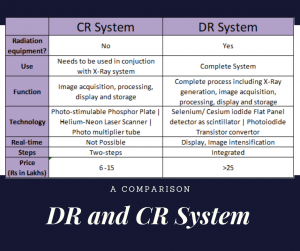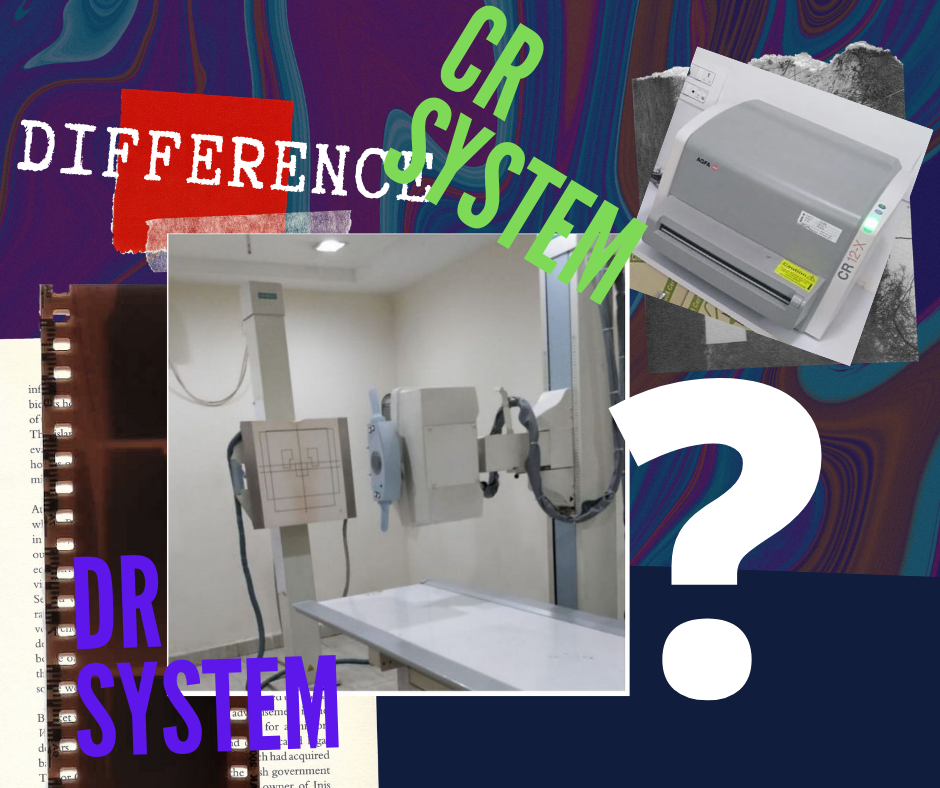
“I want to buy a digital X-Ray” – This is one of the most common requests that we hear at PrimedeQ. On further probing, it turns out that the caller is looking for a CR System to digitize their X-Ray images.
The difference between a Digital Radiography (DR System) and Computed Radiography (CR System) is simply that – DR system is truly a digital X-Ray while CR system is not an X-Ray machine at all. It is like comparing apples to oranges. Why so?
CR System is not a digital X-Ray system as in; it is neither a radiation equipment nor does it replace the X-Ray machine. What it does is, eliminate the X-Ray film from the conventional X-Ray machine. Therefore, we cannot use a CR System in isolation. We use a CR System along with an X-Ray machine.
On the other hand, a DR System is truly a digital X-Ray.
What is difference between Digital X-Ray vs conventional X-Ray machine?
We need to first understand how the x-ray is detected/ captured and image developed in a normal (non-digital) or conventional film-based X-Ray machine. This is required in order to understand the importance of a digital X-Ray or CR System.
Click here to know more about what an X-ray machine is and how it works.
Imaging process in conventional x-ray machine
In all types of X-Ray imaging, the patient is required to lie on a table or against a stand so that the part of the body being X-rayed is between the X-ray source and a component containing a film cassette or digital detector. Upon administration of suitable amount of X-Ray dosage, image is captured in the cassette (if not digital) or the detector (if digital).
In case of conventional X-Ray also called Screen Film Radiography (SFR), the exposed film is removed from the cassette, placed in stainless steel processing frame and developed in the dark room. In the dark-room the X-ray film is immersed in a tank of developer which completes the reduction of the exposed grains of silver halide, and makes the image visible. After a specified time the film is taken out of the developer, rinsed in water and then immersed in the fixer bath. This solution removes the undeveloped emulsion. The image can be inspected in white light. after 10 minutes in the fixer bath the film is washed in running water for half an hour, to remove the processing chemicals and then hung up to dry. The image can be inspected in white light after some time, after the developed film is dry.
Disadvantages of film-based X-ray investigation
From the above details of the film development process one can imagine that the overall investigation process is labour intensive and time-consuming. Often, if the image has not come out properly, the test would have to be carried out again. This is known only after development of the film. Hence the patient would not only have to wait till then but also exposed to X-Ray again. Re-test also leads to film wastage.
Other challenges with film usage were:
- The images cannot be changed in contrast once they have been processed.
- The film is expensive, cannot be re-used and hazardous materials are used for processing.
- Long term storage has to be in physical form and hence retrieval of film is difficult. Also the image cannot be digitalized and stored in a Picture Archival and Communication System (PACS), making it in-accessible widely.
- In the conventional x-rays in earlier days there was limited flexibility for optimizing radiation dose to the patient. A lot of this has been improved tremendously with introduction of high-frequency x-ray machines.
For all the above reasons the conventional film based X-Ray has gone out of favour. Hospitals see a lot of merit in replacing the film development process with a CR System.
How does a CR System work?
To use a Computed radiography (CR system) – instead of the conventional film in the X-Ray machine, a photo-stimulable phosphor plate (cassette) is used for detection of x rays. The exposed plate is scanned with helium-neon laser in the CR system Scanner. The emitted light is captured by a photo-multiplier tube and converted to analogue electrical system, which is then digitised. Once digitized, it can be virtually stored and shared electronically. The image can be later printed as a film in a separate printer. This completely avoids chemical based processing, but still is a process involving two-steps.
In case of X-Ray machine and CR System combination, real time image display or image intensification is obviously not possible.
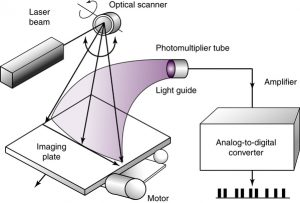
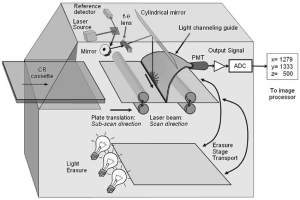
In comparison, Digital Radiography (DR) System is truly the digital X-Ray machine.
What is a Digital X-Ray or Digital Radiography System?
Digital Radiography (DR) system is truly digital X-Ray system, with no film or image processing involved as in CR System. In DR system no inter-mediatry plate/ cassette or film is exposed to the X-Ray. Instead directly flat panel detectors (FPD) are used as scintillators. FPDs convert x-ray photon to light and this is converted to electrons via amorphous silica arranged as photoiodide transistor.
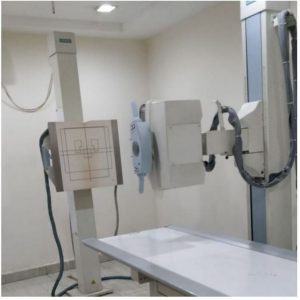
Image intensification is used for real time viewing of images, wherein digital sensors are linked to video monitors. Image intensification increases the image brightness by up to 6000 times without increasing the radiation dose to the patient. This is extremely useful for screening during radiological, vascular, and orthopaedic procedures.
Summary – Difference between Digital Radiography and Computed Radiography Systems
Difference in Cost of DR system vs CR System
DR systems are far more expensive (About 5-10 times costlier than CR systems and 10-20 times costlier than conventional X-Ray). Therefore, DR Systems are typically used in large hospitals with heavy patient volumes and higher-end investigations requirements.
Most hospitals in India today want to eliminate the cumbersome & hazardous dark-room development process. The X-Ray – CR System combination which is essentially film-less and far more cost-effective than a DR system is high in demand. An X-Ray machine (100mA-500mA) would cost between Rs 2-5 lakhs. Minimum cost of a new CR System could be around Rs 6 lakhs. So in less than Rs 1 million one could own a new digital X-Ray system with (X-Ray machine / CR System combo). On the other hand a DR System would be cost more than double that amount. A pre-owned set of equipment could cost 50-65% of the new equipment price.
CR has been known as an indirect digital technology, bridging the gap between x-ray film-based and fully digital detectors. Most hospitals in India are going for the X-Ray – CR System combination (calling it digital X-Ray) since this is far more cost-effective, digital (filmless) and eliminates the cumbersome & hazardous dark-room development process.
PrimedeQ is an eMarketplace for medical equipment. We offer all types of used / refurbished imaging equipment including Fixed X-Ray, Mobile X-Ray, CR System, DR System and C-Arm machine. We also assist in X-Ray machine repair and maintenance services at www.Primedeq.com. Contact us at +918971223957 or +917019759765 for all your medical equipment related needs.
https://in.linkedin.com/in/shanthi-mathur-ab07838

